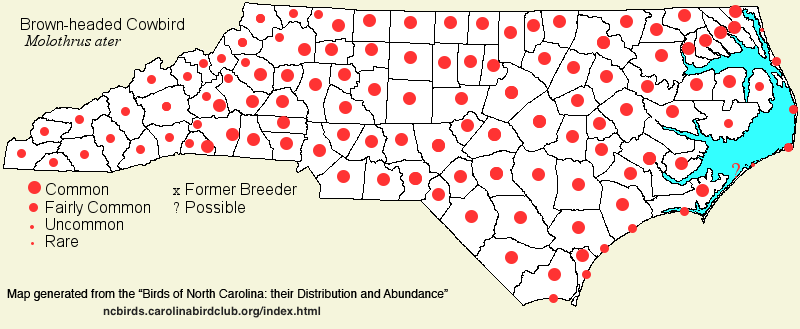 |  |
|
Brown-headed Cowbird - Molothrus ater ICTERIDAE Members: | Search Common: Search Scientific: |
|
|
|||||||
| General Comments | The Brown-headed Cowbird, the continent's most famous/notorious brood parasite (though there are a few others), greatly expanded its former range from the Midwest all the way to the Atlantic Coast about 100-150 years ago, with the opening up of forests to extensive croplands/pasture lands. It is now found over nearly all of the country at all seasons, but it departs the northern states in winter. In North Carolina, it is found statewide in the warmer months but departs the mountains in winter, except sparingly in the lowest elevations. All eggs are deposited in other birds' nests, generally "picking on" species in farmland, open residential areas, and woodland borders, though some forest interior species (such as the Wood Thrush) are parasitized. At all seasons, Cowbirds prefer to feed around cattle and other farm animals, but they also feed in plowed fields, at croplands, on lawns, and on the ground in other short-grass situations. In the colder months, they occur in large flocks, usually mixed with Red-winged Blackbirds, Common Grackles, and/or European Starlings. In fact, by early summer, juvenile birds begin to find other juveniles and adults and quickly form flocks, such that only in spring and very early summer are birds not in flocks. | ||||||
| Breeding Status | Breeder | ||||||
| NC BRC List | Definitive | ||||||
| State Status | |||||||
| U.S. Status | |||||||
| State Rank | S5B,S5N | ||||||
| Global Rank | G5 | ||||||
| Coastal Plain | Permanent resident, with migratory movements. In summer, common throughout, even on coastal islands. At other seasons, common to locally/seasonally abundant, but can be uncommon at times; clearly more numerous in winter than in early summer, except usually uncommon along the Outer Banks and some other coastal islands. Peak counts: | ||||||
| Piedmont | Permanent resident, with migratory movements. In summer, common throughout. In winter, fairly common to at times common in the eastern and southern portions, fairly common in the central portions, and generally uncommon in the western/foothill portions. Can be very common to abundant at times in migration. Less common in winter than in summer. Peak counts: | ||||||
| Mountains | Summer resident, and sparse in winter, with few birds overwintering. In summer, common over the region up to about 4,000 feet, but scarce higher. In early winter, rare to uncommon at lower elevations, but rare by mid-winter, with few overwintering; very rare higher. Can be very common at times in migration. Peak counts: | ||||||
| Finding Tips |
None needed. **** | ||||||
| Attribution | LeGrand[2023-04-02], LeGrand[2012-11-08], LeGrand[2011-12-19] | ||||||
| NC Map Map depicts all counties with a report (transient or resident) for the species. | Click on county for list of all known species. |
| NC Breeding Season Map Map depicts assumed breeding season abundance for the species. |  |